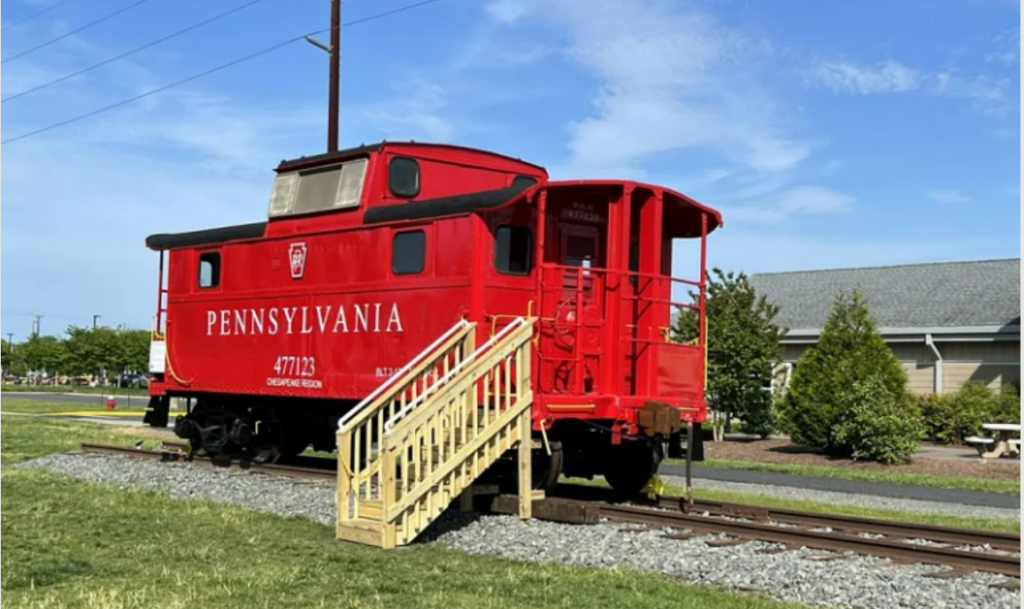David Ludlow, board member and volunteer extraordinaire for the Lewes Junction Railroad & Bridge Association (LJRBA) met with me on a recent summer day. At the Red Caboose on the side of the Lewes Library, of course.
I ended up staying over an hour, fascinated by his knowledge and the organization’s enthusiasm for preserving Sussex County’s railroad heritage. Displaying the caboose publicly is just one of the ongoing efforts to share the historical importance of rail transportation and commerce that literally connected Lewes and surrounding areas with larger cities such as Baltimore, Wilmington and Philadelphia.
Reminders of rail history other than the iconic red caboose abound. The Georgetown-Lewes and Breakwater Junction rail trails are now utilized by thousands of residents and visitors year-round, and we are fortunate to have had civic leaders who had the foresight and leadership to restore the former railway into a recreational gem.
Commercial and passenger service in and around Lewes thrived in the late 19th century. Linking the menhaden factory to large markets depended on rail, as it did for the Morris tomato canning facility in Lewes. (The area was known to locals as Tomato Alley). A milk plant – the remnants that can still be seen on the bike trail – was at Nassau Station, as was a passenger station. Further west towards Georgetown, produce was distributed to the cities, and depended on rail transport.
In World War II, the Lewes railroad was crucial for transporting equipment and supplies to Fort Miles. As someone reflected on the LJRBA website, if the Fort Miles location had been somewhere else, would we in fact have our beloved Cape Henlopen State Park today?
Dave Ludlow explained LJRBA’s mission in three words: preservation, restoration and interpretation. Beginning in 2017 with preservation efforts of the “mechanical marvel” swing bridge that operated service over the Lewes Rehoboth canal for over 100 years until 2015, LJRBA has chugged its way through many financial and logistical challenges. The swing bridge is now on display just off the bike trail at American Legion Road.
The Red Caboose was moved from its restoration site in Georgetown to its current location in 2022 with the help of Coastal Towing. It has had ongoing improvements ever since. It was designed to sleep between 2-4 men, including the conductor and brakeman. The original stove used for cooking and heating is still intact, as are artifacts – some original, some donated. It was built in 1916 and primarily used by the Pennsylvania RR. It recently received a new tar roof.

If you’re curious to know, the exterior is painted in the strikingly bold shade of Viper Red and has even caught the eye of a woman in Missouri who wants to replicate it for a caboose she acquired.
Joining the caboose soon along the tracks in Stango Park will be a built-from-scratch coal tender. Also be sure to notice the replica station building across the tracks. It is a project of Lewes and Art in Bloom, and it adds to the whole rail travel nostalgia.
The biggest undertaking of LJRBA yet will be the addition of the Pennsylvania Railroad’s Steam Engine #60, currently being restored at the workshops of Wilmington & Western Railroad (WWR) in Wilmington. This mammoth locomotive weighing 88 tons was built in 1913 and has not run since the 1940s. The boiler is the last one of a particular style, 0-6-0, which refers to the configuration of its wheels placed under the locomotive engine.
Fundraising is currently underway to complete Engine #60’s restoration, eventually moving it to Stango Park with the blessing of Lewes City Council. Funding so far has come from private gifts and grants, including the DuPont Foundation and the National Railroad Historic Society. Restoration is being done entirely by volunteers (always needed!). As Dave Ludlow puts it, “If we don’t save it, who will? We’ve lit a torch.”
Ludlow has spent a lifetime in the railroad world. He’s a retired former executive director of the Wilmington & Western Railroad, and most certainly was instrumental in arranging the logistics of acquiring Engine #60. His dedication and expertise offered to LJRBA are priceless. Humbly, however, he asked me to shout out to potential volunteers and donors for the organization. Railroad enthusiast or novice, your help would be welcomed.
Taking place annually in May is National Train Day, which commemorates the completion of the Transcontinental Railroad in 1869. A final, golden spike was driven into the track at Promontory, Utah, to connect the east and west coasts of North America. Here in Lewes, National Train Day is celebrated annually as well, and a Golden Spike has been ceremoniously hammered into the track near the caboose. Be sure to visit and look for it, even if you’ve walked or biked past the Red Caboose innumerable times.
The caboose tours are a terrific destination for your visiting guests or grandchildren. After all, who doesn’t love the lure of a red caboose?
For information and photos, and to volunteer or donate, please contact Lewes Junction Railroad & Bridge Association. Don’t miss the train.
By Bridget FitzPatrick